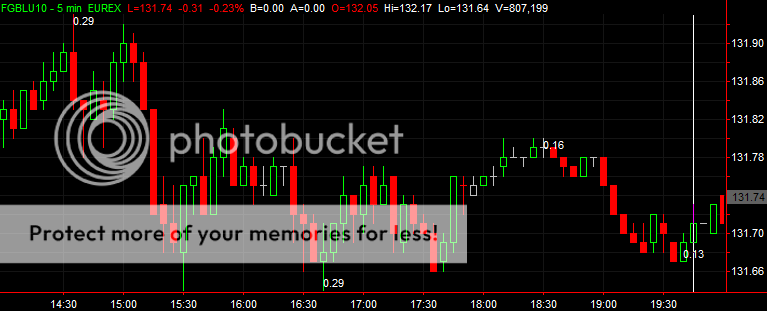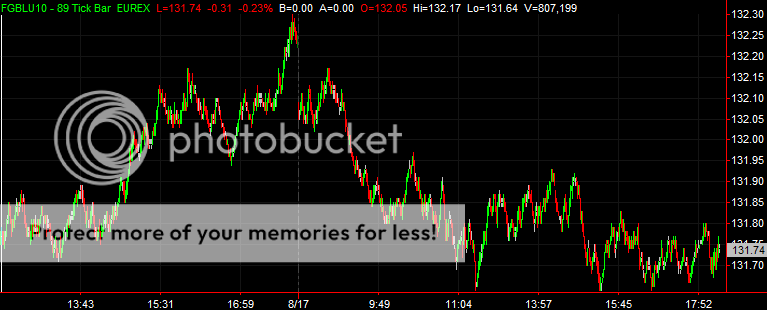DionysusToast
Legendary member
- Messages
- 5,965
- Likes
- 1,501
A common question on here is "which timeframe is best to use?".
I would like to propose that the answer to this is "none".You should not be using any timeframe at all.
Here's a 5 min BUND from last night.

OK - so this looks fine right ? A 5 minute chart, all the candles nice & clear.
Why though do people put so much importance on any individual candle when so many people use them on so many different timeframes? If I said I used 4 and a half minute candles I'd be laughed at but people would have no problem with me suggesting the 1,3,5,10,30 and 60 minute timeframes could be used together to give a better view.
There's an 'expert' (that shall remain nameless) in a chat toom I visited room who talks of the 20 MA on their 1 min chart providing resistance, then says how you need to be careful as the 20 MA on their 350 tick hasn't been pierced yet, and that the 5 min 50 MA is close so that can't be ignored either.
Can it really be that all these MA's on all these different timeframes are relevant? Do they really provide real resistance? I would say no.
I would also say that people put far too much importance on indivindual candles instead of the overall movemement of the market. Is staring at those individual candles steering your attention away from what is important?
Now - here's my BUND chart from last night.

The tick count is 89 - which seems to suit the BUND, you could move this up but 89,100, 70, 75 - it doesn't matter. I could change it at any time and it wouldn't make the slightest bit of difference to what I do. I just use a setting where you can see lots of the action. 89 on the ES wouldn't be very good as you'd not see so much action. The timeframe is irrelevant.
Whilst the time frame is not important, the compression of the chart is. Once you compress the chart, you are effectively making the individual candles unreadable yet still seeing all of the significant price action. You see the wood but not the trees.
You can see the same double bottom on both charts but on the latter chart you can see it in context of the overall price move for the day (and prior days). I did take the trade at that point based on what was also happening on DOM/T&S. I am not advocating taking all double bottoms. It didn't give me much anyway...
I have been looking at charts like this for only about a month now. The result is that I place less trades but the ratio of winners to losers has increased.I get less bored for some reason too - I am not sure why this is but I am much more relaxed.
So - from here on in, I would like to propose that the answer to "what timeframe should I use" is "None".
I would like to propose that the answer to this is "none".You should not be using any timeframe at all.
Here's a 5 min BUND from last night.

OK - so this looks fine right ? A 5 minute chart, all the candles nice & clear.
Why though do people put so much importance on any individual candle when so many people use them on so many different timeframes? If I said I used 4 and a half minute candles I'd be laughed at but people would have no problem with me suggesting the 1,3,5,10,30 and 60 minute timeframes could be used together to give a better view.
There's an 'expert' (that shall remain nameless) in a chat toom I visited room who talks of the 20 MA on their 1 min chart providing resistance, then says how you need to be careful as the 20 MA on their 350 tick hasn't been pierced yet, and that the 5 min 50 MA is close so that can't be ignored either.
Can it really be that all these MA's on all these different timeframes are relevant? Do they really provide real resistance? I would say no.
I would also say that people put far too much importance on indivindual candles instead of the overall movemement of the market. Is staring at those individual candles steering your attention away from what is important?
Now - here's my BUND chart from last night.

The tick count is 89 - which seems to suit the BUND, you could move this up but 89,100, 70, 75 - it doesn't matter. I could change it at any time and it wouldn't make the slightest bit of difference to what I do. I just use a setting where you can see lots of the action. 89 on the ES wouldn't be very good as you'd not see so much action. The timeframe is irrelevant.
Whilst the time frame is not important, the compression of the chart is. Once you compress the chart, you are effectively making the individual candles unreadable yet still seeing all of the significant price action. You see the wood but not the trees.
You can see the same double bottom on both charts but on the latter chart you can see it in context of the overall price move for the day (and prior days). I did take the trade at that point based on what was also happening on DOM/T&S. I am not advocating taking all double bottoms. It didn't give me much anyway...
I have been looking at charts like this for only about a month now. The result is that I place less trades but the ratio of winners to losers has increased.I get less bored for some reason too - I am not sure why this is but I am much more relaxed.
So - from here on in, I would like to propose that the answer to "what timeframe should I use" is "None".
Last edited:
